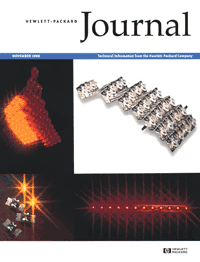
Improvements in LED brightness have resulted in their use in applications that were
formerly the domain of incandescent lamps. For example, LEDs can now
be found in street lights, traffic signals, and automobile signal lamps.
The first
LED signal lamp appeared on a passenger vehicle in 1985. In 1986 the
Nissan 300ZX center high mounted stop lamp used 72 LEDs assembled on
a printed circuit board. With today's LEDs, this same function can be
achieved with 12 LEDs. Because of the reduction in the number of LEDs
required for a particular function, LED packaging and assembly costs
have also been greatly reduced. Compared to conventional incandescent
automotive signal lamps, LEDs have lower power consumption, decreasing
the overall system cost in today's electrically demanding vehicles.
This issue
of the Hewlett-Packard Journal begins with an article about an HP technology
that uses LEDs for automobile taillamps. The technology, called HP SnapLED,
is a three-dimensional assembly technique that allows LEDs to be packaged
into thin taillamps in such a way that they can be customized to conform
to the shape of a particular vehicle. The author describes the design
and manufacturing processes involved in creating the SnapLED assemblies.
Other products
and technologies described in this issue include: two API libraries
for creating applications to access and control OTDRs, a project that
ported a UNIX®-based product to Windows NT®,
the issues involved in integrating technical and corporate data information
systems, a new approach to developing internationalized software, and
two papers from HP internal engineering conferences.
C. L. Leath
Managing Editor
|